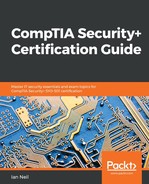In this section, we will look at attacks where he hacker hijacks either a device, cookie, or a piece of software. Let's look at these in turn:
- Bluejacking: Bluejacking is where the attacker has taken control of a Bluetooth device such as a phone. They are then able to make phone calls, send text messages, and even message your friends so that they dislike you.
- Bluesnarfing: Once again, an attacker is hijacking your Bluetooth phone but this time they are extracting your contact details or any sensitive information from your phone.
Input validation could prevent SQL injection, buffer overflow, and integer overflow attacks.
- Session hijacking: When you visit a website, your desktop can store your browsing information in a file called a cookie. This is a security risk as it can used to identify you. For example, the second time you visit a website it may say at the top: Good Morning Mr Smith. If someone can copy your cookie and place it on their machine, the website will also see them as Mr Smith. This is known as session hijacking.
- URL hijacking: URL hijacking is a process in which a website is falsely removed from the results of a search engine and replaced by another web page that links to the remote page. Another form is typosquatting.
- Typosquatting: When someone types in the URL of a website into their browser, they may transpose two characters of the website name as they have typed it very quickly. Typosquatting is where the attacker creates websites with those transposed names to redirect their session to a fraudulent website. This is also known as URL hijacking.
A stored procedure could prevent a SQL injection attack as it is a pre-written script that is executed and cannot be altered when executed.
- Clickjacking. Clickjacking is a malicious technique of tricking a web user into clicking on an icon or link. The outcome is different from what the user perceives they are clicking on, thus potentially revealing confidential information or taking control of their computer. An attacker establishes a malicious website that invisibly embeds the Facebook Like or Share button in a transparent iframe. When the victim clicks within the malicious site, the click is directed to the invisible Like or Share button.
